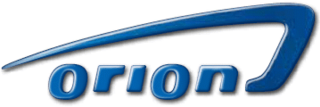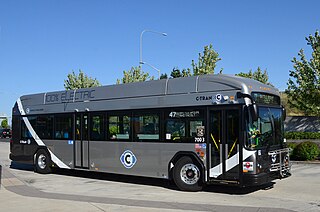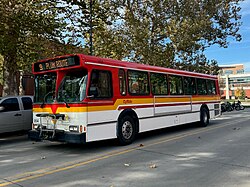North American Bus Industries, Inc. (NABI) was a manufacturer of heavy-duty transit buses with its headquarters, bus manufacturing and assembly operations, located in Anniston, Alabama. Its products ranged from 31-feet to 60-feet in length, and were sold to operators throughout the United States and Puerto Rico. NABI's U.S. operations also include an aftermarket parts division in Delaware, Ohio, and an after-sales service center at Mira Loma, California.

The Neoplan Transliner was a series of related public transport single-decker bus models introduced by Neoplan USA in 1981 and produced until the company declared bankruptcy in 2006. It was available in various lengths ranging from 26 ft (8 m) to 60 ft (18 m) articulated, and was marketed against the Rapid Transit Series, Flxible Metro, Gillig Phantom, New Flyer High Floor, and Orion I.

Orion Bus Industries, also known as Bus Industries of America in the United States, was a private bus manufacturer based in Mississauga, Ontario, Canada.

The Orion I was a line of rigid high-floor transit buses made in 30-, 35-, and 40-foot lengths by Ontario Bus & Truck between 1976 and 1993 for the Canadian and United States mass transportation markets. The Orion I was the first bus offered by OBI and was available in transit (2-door) and coach/suburban (1-door) models. It was replaced by the rigid Orion V and low-floor Orion VI.

The Orion VI was a low-floor transit bus available in 40' lengths manufactured by Ontario Bus Industries between 1995 and 2003. The Orion VI was intended to provide an alternative to the existing high-floor Orion V; both the V and VI were replaced by the partially low-floor Orion VII.

The Orion VII is a line of low-floor transit buses available in 30' rigid, 35' rigid, and 40' rigid lengths manufactured by Daimler Buses North America's subsidiary Orion Bus Industries between 2001 and 2013 in three generations. The conventional powered buses, either with longitudinally-mounted diesel or natural gas engines, used a T-drive transmission coupling. A series hybrid variant powered by a diesel-driven generator was also available. The Orion VII replaced the fully low-floor Orion VI and high-floor Orion V buses, and was manufactured until its parent company DaimlerChrysler withdrew from the transit bus market in 2013.

The Gillig Low Floor is a transit bus manufactured by Gillig since 1997. The second low-floor bus design introduced in the United States, the Low Floor originally served as a second product range for the company alongside the Gillig Phantom. As transit bus operators shifted toward low-floor designs, the Low Floor has replaced the Phantom entirely, becoming the sole vehicle platform offered by the company since 2008.

The Low Floor Series (LFS) is a series of transit buses manufactured by Nova Bus for North American customers from 1996 to the present. It is produced in 40' rigid and 62' articulated (nominal) lengths with a variety of powertrains, including conventionally-fueled, hybrid diesel-electric, and battery-electric. The LFS is the first transit bus designed by Nova Bus.

The Orion-Ikarus 286, commonly known as the Orion III, was an articulated bus marketed to Canadian transit operators by Ontario Bus Industries (OBI). It was produced as a joint venture between Ikarus Body and Coach Works and OBI from 1985 to 1989, and deployed primarily in Ottawa and Toronto. The Orion III fleets were retired prematurely due to corrosion, and all examples were withdrawn from service by 2003.

The MCI D-Series is a model of motorcoach bus produced by Motor Coach Industries (MCI). The bus is primarily used by private companies operating scheduled service or commuter buses, government agencies for the transport of prisoners, and in more recent years, public transit agencies who use them on express routes. It is sold alongside the MCI J-Series bus, primarily used by tour and charter operators.

The New Flyer Xcelsior is a line of transit buses available in 35-foot rigid, 40-foot rigid, and 60-foot articulated nominal lengths manufactured by New Flyer Industries since 2008. In addition to the different available lengths, the buses are sold with a variety of propulsion systems: conventional diesel, compressed natural gas (CNG), diesel-electric hybrid, hydrogen fuel cell, overhead electric wire and battery electric. A future autonomous bus variant was announced in January 2021.

The New Flyer Low Floor is a line of low-floor transit buses that was manufactured by New Flyer Industries between 1991 and 2014. It was available in 30-foot rigid, 35-foot rigid, 40-foot rigid, and 60-foot articulated lengths. In addition to the different available lengths, the buses were sold with a variety of prime movers, ranging from conventional diesel and CNG combustion engines to diesel-electric hybrid, gasoline hybrid, and hydrogen fuel cell.

The Flyer 700/800/900 series were a series of transit buses built in three generations by Western Flyer and its successors Flyer Industries and New Flyer, of Canada, between 1967 and 1987. Except for brief overlap during transition from one generation to the next, they were not in production concurrently. All individual model designations included a prefix of either D, for diesel propulsion, or E, for electrically powered trolleybuses, with the first digit indicating the generation and the last digit indicating a variant within the generation. The introductory model was the D700, originally released in 1967 for the Canadian transit market, and the last series group to be produced, D900, was discontinued in 1987. Flyer had become New Flyer only the year before, in 1986.

The New Flyer High Floor is a line of conventional (high-floor) transit buses available in 35-foot rigid, 40-foot rigid, and 60-foot articulated lengths manufactured by New Flyer Industries between 1987 and 2006. The buses were powered by conventional diesel or natural gas engines using either V-drive or T-drive transmission couplings, with the exception of an articulated electric trolleybus variant manufactured for a single customer, the San Francisco Municipal Railway. The New Flyer Low Floor, a low-floor bus with a similar external appearance, was introduced in 1991 and proved to be more popular than the High Floor, which was discontinued in 1996 in diesel rigid form. CNG high-floor buses continued to be made until 1999, and the articulated version was manufactured until early 2006.

The NABI LFW is a line of low-floor transit buses available in 30' rigid, 35' rigid, 40' rigid, and 60' articulated lengths manufactured by North American Bus Industries (NABI) between 1997 and 2015. In addition to the different available lengths, the buses were sold with a variety of powertrains, including conventional diesel, LNG, and CNG combustion engines along with a diesel-electric hybrid system

The NABI SFW is a line of standard (high)-floor transit buses available in 40-foot rigid and 60-foot articulated nominal lengths, manufactured by the Ikarus USA joint venture, then by American Ikarus and North American Bus Industries (NABI) between 1989 and 2013. In addition to the different lengths, the buses were sold with a variety of prime movers, including conventional diesel and CNG combustion engines and hybrid diesel-electric power.

The NABI CompoBus is a line of low-floor composite-bodied transit buses available in 40' and 45' rigid lengths manufactured by North American Bus Industries (NABI) between 2002 and 2013. In addition to the different available lengths, the buses were sold with a variety of prime movers, ranging from conventional diesel and LNG/CNG combustion engines to diesel-electric hybrid.

The NABI BRT is a line of low-floor transit buses available in 60' articulated (60-BRT) and later 42' rigid (42-BRT) nominal lengths manufactured by North American Bus Industries (NABI) between 2004 and 2015. In addition to the different available lengths, the buses were sold with a variety of prime movers, ranging from conventional diesel and CNG combustion engines to diesel-electric hybrid.

The ENC Axess is a line of low-floor transit buses available in 35-foot and 40-foot nominal lengths manufactured by ENC in Riverside, California starting from 2003. In addition to the different available lengths, the buses are sold with a variety of prime movers, ranging from conventional diesel, LNG/CNG combustion engines, diesel-electric hybrid and hydrogen fuel cell with a traction motor.

The ENC E-Z Rider and its successor E-Z Rider II are a line of low-floor, mid-sized, heavy-duty transit buses available in 30', 32', and 35' nominal lengths manufactured by ENC in Riverside, California starting from 1996. In addition to the different lengths, the buses are available with several powertrain options including traditional diesel, CNG, LNG, Propane, and diesel-electric hybrid.






















